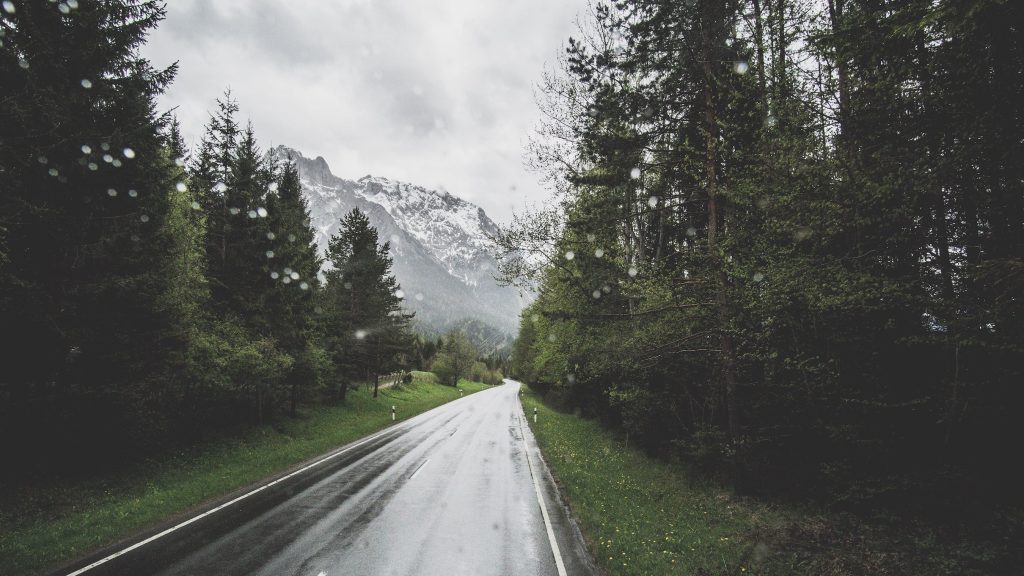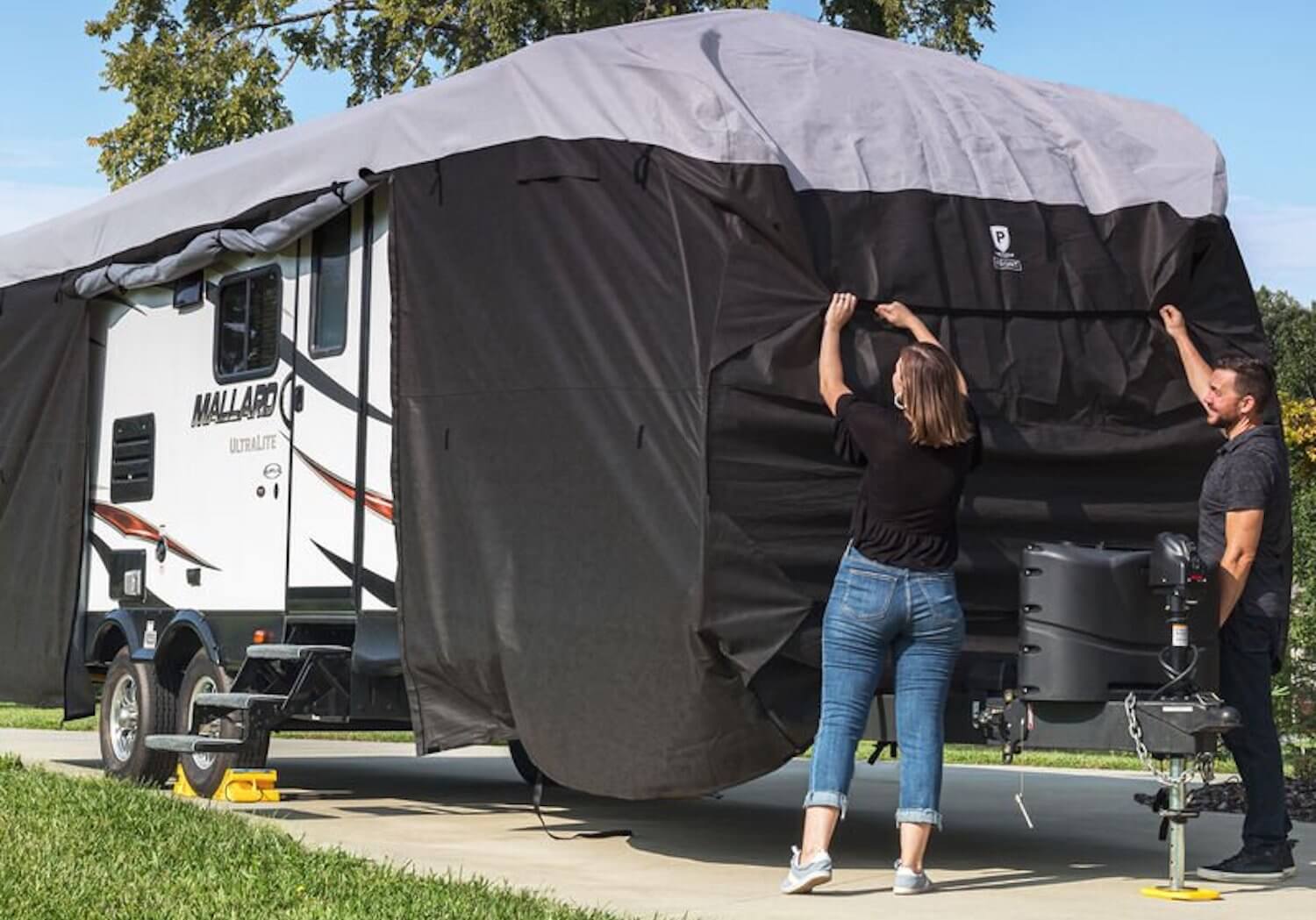Unless you’re constantly on the road or living in your RV full-time, your motorhome is probably sitting in your driveway a fair amount of the time. If you leave it exposed to the elements, the exterior will wear much faster than if it were protected. If storing your RV in an enclosed facility isn’t an option, there’s a simple way to protect your investment—use an RV cover.
RV covers have a variety of benefits. For starters, they keep your exterior in good shape and minimize your prep time when you’re ready to hit the road again. But let’s discuss a few more reasons why using an RV cover is a wise choice.
Why Use an RV Cover?
To be clear, the infamous blue tarp isn’t the kind of RV cover you want to use. While it’ll serve as a short-term option in a pinch, covers specifically designed for motorhomes provide the highest level of protection when it comes to maintaining your RV’s resale value.
Here are a few things RV-specific covers will guard against:
Ultraviolet Light

Whether you’re kicking back by the lake or you’re on the road to find a new campground, It’s hard to argue that a beautiful, sunny day in an RV is hard to beat. But when your RV is sitting in the driveway, the sun’s UV rays are causing the paint to fade, degrading the decals, creating cracks in the roof, and doing damage to your entire coach.
If you leave your RV in the sun without a cover, interior and exterior temperatures will rise dangerously. If your coach heats up too much, it can damage critical, heat-sensitive components. Using an RV cover keeps the temperature of your RV down by deflecting direct sunlight.
Over time, UV exposure can even degrade a high-quality RV cover, but covers are much less expensive to replace than the cost of repainting your whole RV. The best way to avoid UV degradation is to park your RV in a covered storage area. The second-best way is to use an RV cover.
Moisture

Water is perhaps an RV’s greatest enemy, especially when trapped under a tarp. If condensation gets caught between your RV and a tarp, it provides a breeding ground for mold and mildew. In places that experience extremely cold temperatures, it can lead to freezing and cracking around the roof.
Most good RV covers are waterproof and, yet, still breathable. Tiny pores in the fabric allow moisture to escape without preventing water droplets from getting in. As long as you choose a cover made specifically for RVs, you shouldn’t have to worry about moisture getting trapped underneath.
If you do find moisture on the exterior walls of your RV when it’s covered, consider running a portable, battery-operated fan to promote better airflow under the cover. Run your fan for 2-3 hours at least once a week to minimize the build-up of moisture and condensation under your RV cover.
When in long-term RV storage, you can also periodically remove and clean your cover. Wait for a stretch of 3-4 days with warm temperatures (above freezing) and no chance of precipitation. Remove the cover and clean any obvious spots of mold growth with a sponge and a mild soap before letting the fabric dry completely and replacing it.
Whether it’s related to your RV cover or window treatments, here are some more tips for how to manage moisture and condensation in your RV.
Wind

The wind blows leaves, pine cones, pollen, and just about any other airborne debris you can imagine onto your RV. If it’s not covered, your RV can sustain damage from flying particulates when a big wind storm comes through.
Breezy conditions can even catch tarps and covers, causing them to billow out. This leads to strain on any straps, bungee cords, or ropes holding them in place. If that strain is too great, it can rip the fabric, tear the restraints, or cause loose straps to smack dangerously against your RV. This is why higher-quality RV and toy-hauler covers come with vents to reduce billowing.
Dirt

Unless you’re dying to wash your RV weekly, a good cover is the easiest way to protect it from dirt and dust. These sediments can cause wear and tear to parts, components, and your RV’s exterior over time.
Leaving your RV uncovered opens it up to anything and everything in the environment. With a cover, you won’t have to worry about bird droppings, stuck-on leaves, and other general muck when it comes time for your RV spring cleaning before you hit the road.
How to Choose the Right RV Cover

Covers for recreational vehicles are made to fit all RV sizes and designs. For example, covers for Class A RVs are going to be shaped much differently than those designed for R-Pod trailers. You can even have a custom cover made-to-order for the snuggest fit.
Here are a few tips to help you choose the right cover for your RV:
- Covers made of weather-resistant fabric offer the most protection against rain and snow
- Breathable materials are best for preventing mold and mildew growth
- Reinforced corners reduce the chances of tears or frays
- Polyester or polypropylene covers are best for blocking UV rays
- Double or triple-layered covers with UV treatments provide extra UV protection
- Vent flaps are the key to reducing billowing and strain on straps
- Elastic around the base and straps underneath keep your cover in place in high winds
- Lighter-colored covers stay cooler in hot climates or direct sunlight
What to Consider When Covering Your RV
While they are the best way to protect your RV from the elements, getting your cover onto your RV can be a challenge if you’ve never done it before. One of the best approaches is to choose a day with minimal winds to install your cover for the first time. When doing so, here are a few more tips for getting your cover in place without damaging it, or your RV, in the process.
Step 1: Clean and Dry Your RV

There’s no sense in putting a cover over a dirty RV. Cleaning and disinfecting your vehicle after each trip is an RVing best practice, and it decreases your prep time when you’re ready to hit the road again. Just make sure you allow your motorhome or trailer to dry completely after you’ve cleaned it, so you don’t trap moisture in when you put the cover on.
This is also a great time to double-check that your RV furnace and water heater aren’t still active. The heat expelled from the exterior vents of these appliances can easily melt a hole in your RV cover if they are left running.
Step 2: Unfurl the Cover

Unfold or unroll your cover completely and disconnect all the straps along the edges so they don’t catch on anything during the installation process. Then, locate the front of the cover and roll it from back to the front, keeping it unfolded widthwise. This will allow you to start at the front and work your way back when you’re up on your RV’s roof during the next step.
Step 3: Get Your Cover Onto the Roof

You may need to fold your cover in thirds widthwise to make it easier to get it over the top of your vehicle. If your coach has a permanent RV ladder, use this to get up onto the roof. Otherwise, you’ll need a folding or telescoping ladder to get your cover and yourself up there.
If you have someone nearby that can assist, have them hand the cover to you. Alternatively, use a 15-20 foot section of rope and secure it around your cover before you climb up the ladder. Take one end of the rope with you and use it to hoist up your cover once you’re safely up the ladder.
Step 4: Install Cover From Front to Back

Take your cover to the front of your coach and unfold it widthwise. Then unfold it once or twice lengthwise so you can start lowering the front edge over the front of your RV. Work your way backward by unfolding the cover as you walk towards the back of your coach. Be careful to avoid your RV air conditioner and any roof vents that might be in your way.
Also, make sure your cover doesn’t get hung up or caught on any of these roof-mounted accessories as you go. Make sure that the cover is draped over the sides of your RV so it naturally falls to the ground when you bring the back edge over the rear of the vehicle.
Once you reach the back of your RV, carefully climb down your ladder, bringing the cover down the back wall as you descend.
If your RV doesn’t have a walkable roof, you will need someone to assist and two ladders to slowly work your way from front to back, section-by-section, when installing the cover.
Step 5: Connect the Straps

You may need to use a portable ladder to go around your RV and make sure the sides of your cover are draping all the way down to the ground. Once your cover is sufficiently in place, find the edge with the longer straps. Usually, these will have the male end of the buckle on them.
Some RV covers have weighted straps that make them easier to toss under your coach so that you don’t have to crawl underneath. Regardless of the exact design, however, your final step is to connect all the straps that run beneath the vehicle and tighten them in place. This will help to reduce billowing. If you anticipate high winds, it’s always a good idea to go back and re-tighten these straps, as they can loosen over time.
An RV cover protects your investment and helps keep your rig in traveling shape. Isn’t it worth it to be ready to go when the mood strikes you? Camping World carries a wide selection of covers for all types of motorhomes and travel trailers, including the new Happier Camper, and we’re happy to help you find the perfect fit for your RV.










We have our Camper in a barn and a cover over it. Is that a NO NO? My husband did say that there was some moisture under the cover on a warmer day.
You mention keeping RV under a cover. I have an Adco cover on class A MH and live in a rainy
winter climate. My cover appears to have a black mossy appearance in spots that when spring comes and things dry out, I’d like to clean the cover. What is best way and ethod to clean the cover. Also, despite it being a breathable cover I’ve noticed condensation on the vertical walls. Is this a problem or to be expected.
Hi Marlenea, if it’s in a barn it probably doesn’t need the cover. As long as there’s a little bit of airflow under the cover it should be fine, though.
I have had the same problem to much sun on cover causes black mold not enough sun causes green mold like moss. I use dawn dish washing soap on mine